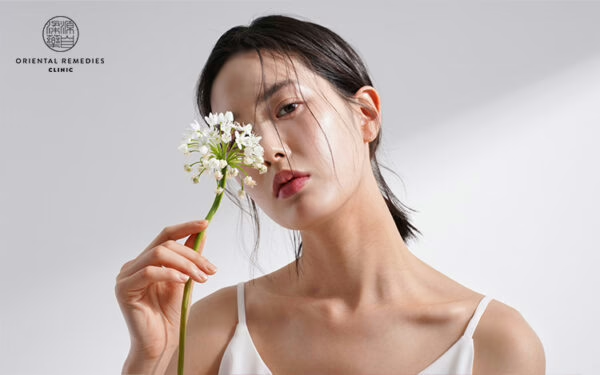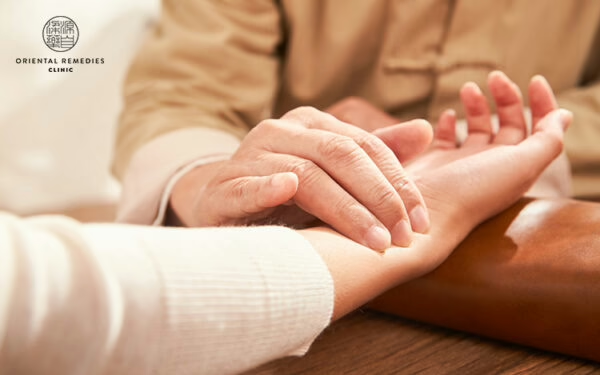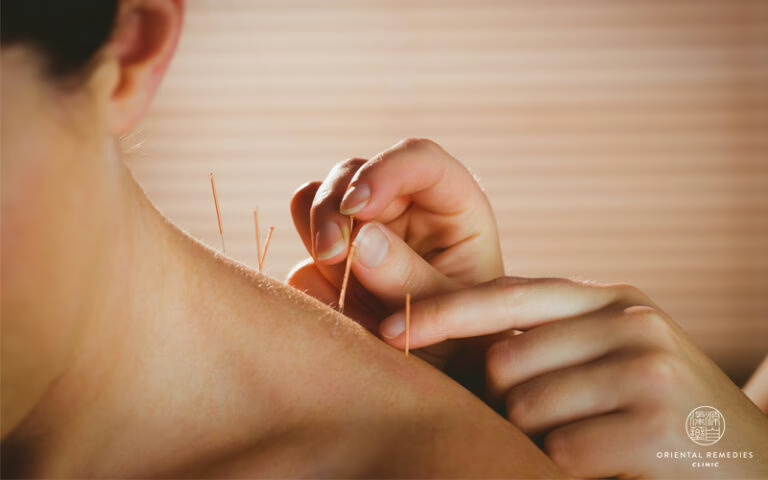Why Facial Acupuncture is Gaining Popularity in the Era of Clean Beauty

Link copied! Achieving healthy, radiant skin doesn’t have to mean relying on chemical peels, injectables, or synthetic skincare products. As more people shift towards clean beauty, the demand for natural skincare solutions is higher than ever. This is where facial acupuncture comes in—a traditional practice that gently stimulates collagen production, enhances circulation, and supports overall skin health. But what makes facial acupuncture different from other conventional beauty treatments? Here’s what you need to know. What is Clean Beauty? Clean beauty takes a natural and holistic approach to skincare and makeup. It involves choosing products made from safe, eco-friendly, and non-toxic ingredients—free from harsh chemicals, artificial additives, and synthetic fragrances. However, clean beauty is more than just the products you use—it’s also about the choices you make for your skin in the long run. Instead of relying on aggressive procedures and formulations, more people are now turning to treatments that work in harmony with their skin. This approach helps to support skin health gently and sustainably, maintaining the body’s natural balance while promoting lasting results. How Facial Acupuncture Supports Clean Beauty Goals If you’re looking for a skincare solution that aligns with the principles of non-toxic beauty, facial acupuncture offers an organic way to rejuvenate your skin. 1. Collagen Stimulation Unlike conventional beauty treatments that rely on chemicals or invasive methods, facial acupuncture is a skin rejuvenation technique that naturally stimulates the body’s own healing mechanisms. Fine needles are gently inserted into specific points on the face, stimulating the flow of Qi and enhancing microcirculation to promote cell turnover and natural repair. This process helps support the production of collagen and elastin, which can reduce the appearance of fine lines and wrinkles. Facial acupuncture can also help lift and tone facial muscles, contributing to firmer, more youthful-looking skin over time. 2. Treating Skin from the Inside Out Have you ever noticed that your skin looks dull or irritated when you’re stressed, sleep-deprived, or experiencing digestive issues? According to TCM physicians in Singapore, your skin is a reflection of your overall health. Facial acupuncture doesn’t just target the surface of your skin—it also helps restore internal balance, addressing underlying factors like poor circulation, stress, and hormonal imbalances. Additionally, it can help balance oil production, which can be particularly helpful for those struggling with acne or breakouts. 3. A Complementary Treatment to Facial Gua Sha Facial acupuncture is often paired with facial gua sha—a technique that involves scraping motions across the skin using a smooth-edged tool usually made of jade. This combination is commonly used to encourage circulation and ease facial tension, leading to a firmer and more radiant complexion. How to Incorporate Facial Acupuncture into Your Beauty Routine If you’re considering facial acupuncture as part of your beauty routine, here are some tips to help you get started. 1. Set Realistic Expectations Facial acupuncture isn’t a quick fix like Botox or fillers. It’s a gradual process that focuses on improving skin health over time. Most people notice subtle improvements after the first few sessions, with more visible results typically appearing after 7-8 treatments. Consistent follow-up visits are usually needed to maintain progress, so it’s important to approach the treatment with patience and the right mindset. 2. Listen to Your Skin Your skin is unique, and how it responds to facial acupuncture may vary. Pay attention to any changes, and don’t hesitate to discuss concerns with your practitioner. It’s normal to experience a slight flush or warmth after treatment due to increased circulation, but this typically fades quickly. Staying in tune with how your skin responds will help you get the most out of the experience. 3. Find a Qualified Practitioner To ensure you receive the best care, seek out a licensed TCM practitioner experienced in facial treatments through TCM techniques. An unqualified practitioner may neglect proper techniques or hygiene standards, increasing the risk of infection, prolonged inflammation, or poor treatment outcomes. To ensure safe and effective care, choose a trusted provider like Oriental Remedies Clinic, where our experienced TCM physicians prioritise proper technique, hygiene, and personalised treatment in a trusted and supportive environment. Is Facial Acupuncture Right for You? For those looking to commit to a clean beauty lifestyle, facial acupuncture could be the natural solution you’ve been searching for. By enhancing microcirculation and addressing internal imbalances, facial acupuncture promotes not just a healthy, radiant complexion but also overall well-being from within. Ready to explore this natural skincare approach? Contact Oriental Remedies Clinic to make your first appointment today. RELATED TOPICS YOU MIGHT ALSO LIKE
What Happens When You Visit a TCM Physician?

Link copied! If you are considering visiting a Traditional Chinese Medicine (TCM) physician, you might be wondering what the experience entails. Oriental Remedies Clinic is a registered TCM in Singapore with a unique approach where we combine ancient wisdom with modern technology. In this article, we take you throughwhat happens during your first consultation for an accurate diagnosis and effective treatment plans. Keep reading to find out more. The Oriental Remedies Clinic Difference During your consultation with our TCM physicians, you will discover a distinctive approach to diagnosis. Our physicians integrate both the traditional TCM perspective and a Western understanding of your condition to provide a comprehensive evaluation of your health. They take the time to review any medical reports or scans you may have, ensuring a holistic understanding of your well-being. We also offer tech-enhanced wellness assessments that provide additional insights into your body condition and aid in tracking and visualising improvements in your recovery progress. These assessments are designed to complement our TCM physician’s expertise, not replace it. Furthermore, one of the key features that sets us apart is our commitment to personalised and transparent treatment plans. When you visit us, you can expect a treatment plan tailored to your unique needs. If you have concerns about certain therapies and would like alternatives, feel free to consult our physicians for other treatment options. We believe in keeping you fully informed about the treatments, ensuring transparency in every step of your healing journey. Our unique tech-enhanced TCM approach also includes the use of modern technology in our treatment plans. Tech-enhanced therapies such as Electro-Lymphatic Therapy (ELT), Cell Pro Therapy, and Far-Infrared Therapy are used to complement traditional TCM treatments, providing you with holistic support, accelerated recovery and an elevated wellness experience. What Happens During Your TCM Consultation 1. Observation Our TCM physician begins by closely observing you — they examine your tongue, evaluate your complexion, and even pay attention to how you sound. These subtle observations provide valuable insights into your overall health. 2. Inquiry To get a comprehensive understanding of your condition, the TCM physician will inquire about the symptoms you are experiencing and your lifestyle habits. They will also ask about your medical history and evaluate medical reports, as they play a significant role in forming a diagnosis. If you are unsure what reports to prepare for your consultation, contact our customer service team at +65 8087 0486 before your appointment for more information. 3. Analysis Feeling your pulse is a crucial part of the TCM diagnostic process. It helps the physician assess the balance of energy in your body and identifies areas that may need attention. At this time, our wellness specialist may utilise tech-enhanced wellness assessments to delve deeper and identify other concerns for our TCM physicians to investigate. 4. Diagnosis and Treatment After gathering all the necessary information, the physician forms a diagnosis and devises a treatment plan. You can typically commence treatment on the same day. Tech-Enhanced Wellness Assessments at Oriental Remedies Clinic Our tech-enhanced wellness assessments are designed to give you a comprehensive understanding of your health, allowing us to tailor your treatment plan to your unique needs. It also serves as a means of tracking and visualising your recovery progress. 1. Biowell Meridian Scan The Biowell Meridian Scan is a wellness assessment that delves deep into your body’s meridian energy and organ health. By capturing finger scans using Gas Discharge Visualisation technology, this scan provides valuable insights into the energy and stress evaluations based on meridians and acupuncture points. The TCM physician will look at your reports to identify abnormal energy distribution across different body parts or energy imbalances in your organs or systems to investigate further. They will then ask questions about symptoms or discomfort that you may be experiencing relating to these areas. Insights from the Biowell Meridian Scan help us pace your treatment more effectively and advise you on planning your daily activities for optimal productivity. It is a holistic approach to health and well-being that goes beyond the surface. 2. Heart Rate Variability Assessment The Heart Rate Variability (HRV) assessment measures the time interval between heartbeats to gain insights into your mental or physical stress and autonomic nervous system activity. It provides a window into your body’s ability to manage and respond to external changes. Using insights from the HRV assessment and inquiry into your lifestyle habits, our TCM physicians can offer advice with even more personalisation. For instance, if your stress index is high despite feeling energetic, they may recommend slowing down and finding ways to unwind physically and mentally. 3. Thermography Body Heat Map Infrared thermography is a fast, non-invasive, and painless assessment that maps the body’s surface temperature, revealing areas of inflammation and poor blood circulation. It is useful in identifying sub-health conditions like chronic inflammation or poor peripheral circulation that often go undetected and can potentially cause health issues in the near future.* Our TCM physicians will review the colours and evenness of their spread on the chart, with white indicating the hottest areas, followed by red, yellow, and blue. Unevenness and the presence of yellow or blue indicate poor circulation, while areas high in temperature often signify acute inflammation typically arising from injuries. *Thermography Body Heat Map is not a medical diagnostic tool but insights from it can be used to advise you on further medical assessments you may require. Learn more: The Evolution of TCM: From Traditional Methods to New Tech-Enhanced Wellness Assessments & Therapies TCM at Oriental Remedies Clinic: Where Tradition Meets Innovation When you visit a TCM physician at Oriental Remedies Clinic, you can expect a comprehensive evaluation of your health. Our physicians are dedicated to providing personalised, transparent treatment plans, and they utilise tech-enhanced wellness assessments and therapies to provide you with the best wellness support alongside TCM treatments and lifestyle advice. This unique combination of ancient wisdom and modern technology allows us to offer the optimum and tailored care for our patients. Book an appointment today.
6 Common Myths About Acupuncture Debunked

Link copied! There is so much more to Traditional Chinese Medicine (TCM) than meets the eye. The practice is deeply rooted in the belief that good Qi flow keeps an individual’s mental, physical and emotional state balanced, promoting overall health in return. Acupuncture, in particular, is a TCM therapy with approximately 2,000 years of history that has skyrocketed in popularity over the years. This ancient practice is known for its ability to create or restore Qi flow through the body for improved health and even rapid pain relief. Effective for a variety of conditions, acupuncture helps with issues ranging from chronic bodily pains to digestive problems like gastritis, common sleep disorders like insomnia and even emotional woes such as anxiety. Despite being a renowned TCM therapy, there are still myths surrounding acupuncture. If you are feeling apprehensive about going for acupuncture, these myths debunked will hopefully convince you to take a leap of faith – keep reading to find out more. Myth 1: Acupuncture is painful One of the most common misconceptions about acupuncture is that it is painful since it involves the insertion of needles into acupoints of the body. On the contrary, very thin needles are used and you will usually only feel a slight prick and tingling. Most people feel at ease during an acupuncture session once the needle passes through the skin’s pain receptor, so there is no need to worry about any unbearable discomfort. Any soreness and pressure will also be relieved when Qi flow is established, usually shortly after the insertion of the needles. However, in the unlikely event that you experience pain or discomfort, do not hesitate to sound it out to your TCM physician. Learn more: Is Acupuncture Painful? Myth 2: Acupuncture is only effective in treating pain Although acupuncture is most commonly known as a TCM therapy to provide pain relief, it is, in fact, a versatile treatment that has way more benefits than that. Acupuncture can also boost fertility, improve insomnia, alleviate depression and anxiety, and aid in weight loss just to name a few. Speak to your TCM physician to find out if acupuncture is right for you. Myth 3: Acupuncture is accompanied by bad side effects The good news is unlike taking medications and undergoing invasive medical procedures, acupuncture promotes the body’s natural healing ability through enhancing Qi flow, and is generally safe with minimal and short-term side effects. You can expect to feel some soreness or see light bruising but these side effects should resolve on their own within a few hours or days. It is also important that you visit a trained and certified TCM physician in Singapore for acupuncture sessions for greater peace of mind. Myth 4: One session of acupuncture is sufficient While you will see and experience the benefits of acupuncture after just one session, consistency is key for optimum and longer-lasting results. Your TCM physician will be able to advise you on the frequency and duration based on your unique needs and it is advisable to stick to them. Once you have achieved your health goals, you should be able to slowly reduce the number of acupuncture sessions. Myth 5: Acupuncture is the same as dry needling Both acupuncture and dry needling require the insertion of needles but their similarity stops there. They are two different therapies done by different practitioners – acupuncture focuses on stimulating the acupoints on meridians to promote overall health while dry needling focuses on trigger points for muscle release. Go for acupuncture if you are looking for a holistic approach to treating a wide range of conditions. Myth 6: Acupuncture is not backed by science Another common misconception about acupuncture is that it is an ancient folk practice not backed by science. While more research still has to be done, some studies have shown that acupuncture may be helpful for many pain conditions ranging from neck pain to knee pain arising from osteoarthritis. This could be thanks to the effects on the tissues where the needles are inserted. Get acupuncture done in Singapore at Oriental Remedies Group At Oriental Remedies Group, our TCM physicians are trained and have years of experience under their belts in providing acupuncture for patients suffering from a wide range of conditions. Book an appointment today to experience the benefits of acupuncture for yourself! Note: all words in Italics mentioned henceforth refer to the TCM organ system and not the anatomical organs/terms referenced in western medicine. Disclaimer: The information on this page is for information and educational purposes only. Such medical information may relate to disease, injury, drugs and other treatments, medical devices and/or health products. Medical information does not amount to advice, and if advice is needed an appropriate professional help should be sought. The disclaimer asserts that no warranties or representations are given in respect of the medical information, and that the website operator should not be held liable if a user suffers any injury or loss after relying upon the medical information. All wellness assessments and technology-enhanced therapies using wellness device(s) are intended for use only for general well-being purposes or to encourage or maintain a healthy lifestyle, and it is not intended to be used for any medical purposes (such as detection, diagnosis, monitoring, management or treatment of any medical condition or disease). Any health-related information provided by these devices should not be treated as a medical advice. Please consult a physician for any medical advice required. Please consult a physician for any medical advice required. RELATED TOPICS YOU MIGHT ALSO LIKE